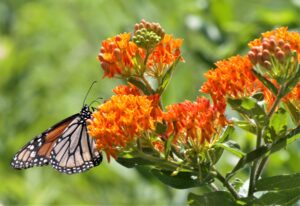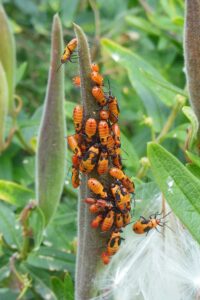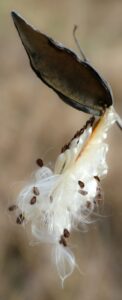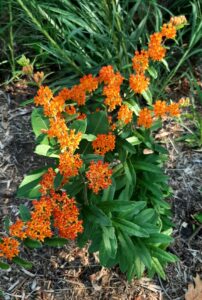Butterfly Weed (Asclepias tuberosa)


– Light: Needs full to part sun.
– Soil and water: Medium wet to medium dry soil. Avoid wet soils or soils that do not drain well. Fertilizer is not needed and as one of the reasons to add this plant to your garden is to encourage Monarch Butterflies – who use this plant at all stages of their life – do not use any chemicals anywhere near the plants. Butterflies are sensitive to all chemicals (fertilizers, pesticides, and herbicides) and will not survive with prolonged contact.
– Hardiness Zone: Zones 3-9.
– Size: Height is 1-2½ ft. Spread is 1-1½ ft. Growth habit is a bushy clump.
– Bloom period and deadheading: Blooms orange in June and July. Flowers are in showy clusters (umbels) held above the plant. No support is needed. Deadheading is discussed in the next paragraph.
- – Insects, butterflies, birds?: Butterflies, moths, and hummingbirds are drawn to the flowers of this plant.
-

Milkweed Bugs congregating on a seed pod of Butterfly Weed. They are on my plants every late summer-early fall and my plants have never been harmed. Such good-looking bugs! It is possible they could reduce the number of viable seeds the plant produces and these plants are important to Monarchs. However, I have never removed any of these bugs from my plants and I get volunteer Butterfly Weed plants in my garden each spring. Please allow them a place in your garden. Photo by L. H. Spence Interesting seed pods form in late summer-fall. These can be removed (or faded blooms deadheaded) to keep the parent plant stronger but consider allowing several pods to produce seeds. I never deadhead mine nor remove any seed pods. If you allow the seed pods to develop, you may find them covered with milkweed bugs – they are feeding on the seeds inside the pod. They are considered more of a nuisance than a threat to the plant and its ability to self-seed. And aren’t they a good-looking bug? So if you find them on your plants, consider leaving them alone. I do on mine.
Deer, rabbits, and other pests: Deer tend to avoid this plant. I have a healthy rabbit population – these rabbits have never bothered them. However, butterflies and moths will come to the flowers. Monarch Butterflies will lay their eggs on the plant, and their caterpillars will eat the leaves. There may be times your Butterfly Weed will look bedraggled and chewed-on, but in almost all cases, your plant will recover and do well the next season. And isn’t that one of the reasons we plant Butterfly Weeds in our gardens – to give Monarchs as much help as we can?
Disease free.
The only problem I have ever had with Butterfly Weed – and this includes all of the milkweed family – is aphids. Keep an eye on these plants and at the first sign of aphids, put on a pair of rubber gloves and get a container of water. Where the aphids are congregated on the plant, wet your gloved fingers in the water and run your fingers over the affected stems and leaves – squishing as you go. These tiny insects can be hard to see. Look for them on the undersides of the leaves along the main rib and on the plant stems. There are expert gardeners who state that aphids do not harm plants. I strongly disagree. I have lost several Butterfly Weeds to aphids, so it is my recommendation to you to be vigilant. About June 15th, start checking your plants each week. Aphids are extremely prolific breeders and even if you think you removed all of them from a plant, it generally takes three treatments – once a week – for you to be sure they are gone. And keep checking the plants until the end of September.
You may find in gardening books and online that one of the recommended treatments for aphids is to

spray the affected plant with a strong stream of water from a hose. I do not recommend this as I have never found that takes care of all the aphids. Plus, as the season goes on, Monarch Butterflies lay their eggs on these plants. These eggs are very small – almost impossible to see without a magnifying glass. If you only use gloves, water, and squish the aphids exactly where they are, your chances of also destroying Monarch Butterfly eggs are small. If you spray a strong stream of water at the plant, that will also dislodge any eggs. So my advice is – don’t do this. Use the gloves, water, and squish.
Lady bugs are a good predator of aphids so check your Butterfly Weed and the surrounding plants to see if you can locate any. If you only have a small amount of aphids and several lady bugs, the lady bugs should be able to take care of the problem for you – just check the plants every few days to make sure that is happening. However, aphids are prolific breeders and can have several generations in just a few weeks so what one day is just a few aphids, in two weeks can be an infestation. If that happens, you are past what lady bugs can do for you and need to take steps yourself.
Propagating and transplanting: Choose your spot carefully. Once in the ground, even during the first year, these plants do not transplant well. They quickly send out a long taproot which is easily broken and once it is broken, the plant dies. I have tried moving them, and I am a careful transplanter. I have never been successful.

Butterfly Weed propagates itself through its seeds. Each pod contains hundreds and when the pods split open, the seeds burst forth and are carried away by the wind. Because the seeds will travel wherever the wind blows them, not many will land in your garden so do not rely on replacement plants from your parent plants. Just count yourself as fortunate if you get a few volunteers. Check your garden in mid-June for these volunteers and if they are where you do not want them, this is the time to transplant them to better spots. Once Butterfly Weed is established, it does not transplant well. it has a very long taproot which is impossible to dig out intact. Breaking the taproot kills the plant, so if you have to move a Butterfly Weed, move it when it is very young or within weeks of planting it. Once it has been in its spot for a year, digging it out is just about impossible.
If you are starting plants from seed you bought or saved, they do need a period of cold stratification of 30 days. Instructions for this are online. What I want to caution you about is how you plant them. Many gardeners start their seeds in flats, and then separate the seedlings and place each into individual pots. This does not work well for Butterfly Weed – it does not like to be transplanted at any stage of its life. Sow your seeds directly into small pots – 4″ pots are a good size. Place 3 seeds in each pot but only allow 1 to grow. Do not pull out the extras – use sharp scissors to cut the extras off at soil level. The point is not to disturb the roots of the plant you want to grow. Butterfly Weed will tolerate being transplanted from the pot to its place in your garden, but it generally will not tolerate being transplanted from a flat, where its seed germinated, to a pot.
Another way to propagate is to prepare your place for them in the garden in late summer/early fall, and plant the seeds directly into the garden soil. Lightly cover the seeds and keep the soil moist. You will probably not see any germination until the following spring – and remember, they are late to break ground.
What to plant with Butterfly Weed: To extend bloom in your garden, consider adding asters for fall bloom and columbines (Aquilegia

canadensis) for spring bloom. Plants that bloom at the same time that make good companions are Black-eyed Susans, Hoary Vervain, and Shasta Daisies.
How to use this plant: Because Butterfly Weeds have a bushy habit, they can be used to hide the foliage of declining spring ephemerals such as Trillium or Spring Beauty (Claytonia virginia) – or from spring bulbs such as daffodils, tulips, and crocus.
This is a beautiful perennial that from its second year, will most often be a fairly dense clump that will resemble a small shrub. Keeping its height in mind, it can be used to camouflage something like a pipe or a stump or soften a hard edge like the edge of a sidewalk or driveway. Butterfly Weed also looks good planted against a stone wall or a wooden/vinyl privacy fence. Keep in mind that generally this is a shorter-lived perennial. In my experience, its lifespan is about 5 years. I have had some that have lived 7-8 years. So, this perennial will probably have to be replaced more often than some of your other perennials. But this is such a beautiful plant both in flower and when the seed pods form, that it is worth replacing it more often.
Butterfly Weeds are one of the last plants to break ground in the spring. Consider marking their spots with plant tags or small sticks so you remember where they are. They can break ground as early as mid-May but often do not show any signs of life until the first week in June. So give them time.

